Abstract
This essay surveys the shifting emotional regimes in Western art from the eighteenth century into the twenty-first, concentrating on the place accorded social affections. In particular, it calls attention to a significant change underway in recent decades as the suppression of the full range of emotions instigated by modernism has been challenged and the tender emotions re-embraced. Important contemporary artists, such as Hank Willis Thomas and Emily Hass, are invoking and exploring themes of love, care, empathy, and concern and, in many cases, making creative use of them to advance social, political, and environmental justice.
Love. Tenderness. Empathy. Compassion. Care. Words and feelings long suppressed in artistic and critical vocabularies are rebounding. Artists are embracing and expressing such feelings in their work. Museums and galleries are acknowledging this in exhibitions with titles such as Tender Loving Care at the Museum of Fine Arts, Boston (2023), No Justice without Love at the Ford Foundation Gallery in New York (2023), and What is Left Unspoken, Love at the High Museum in Atlanta (2022). The emotions surging through contemporary art are undergoing a sea change.
Since this issue of Arts is devoted to “affect”, I should say before I go any further that I am not an adherent to contemporary affect theory. My views of it largely align with those of historian Ruth Leys, who has incisively critiqued the positions of its major theorists; she fundamentally disagrees with the divide they draw between affect and cognition, assigning them to separate systems, with affects defined opaquely as non-cognitive “intensities”.1 On the other hand, I am keenly interested in affect to the extent that the word is understood broadly as embracing emotions, sentiments, and feelings. My concerns lie not in the neuroscience of emotions (so important to many affect theorists) but in their history, particularly their history in relation to art and in what I see as a shift in the emotions that are considered acceptable for expression in the art world today.
Historian William Reddy argues that states, cultures, and communities establish and enforce “emotional regimes”.2 These regimes prescribe and enforce appropriate and inappropriate emotional expression. Reddy’s focus is primarily on the political realm and the roles that emotional regimes play within it. To him, the arts serve as spaces of “emotional refuge”, where people can experience emotions proscribed in the broader public/political realm. These artistic spaces of release and relaxation, he writes, “may shore up or threaten the existing emotional regime” (Reddy 2001, p. 129).
The arts, I believe, have their own emotional regimes that may both align with and depart from those of the broader culture. Prominent artists, critics, curators, gallerists, art school professors, and other visible and vocal figures establish the prevailing emotional regime of a given time and place. Of course, not all artists will fall in line, and some groups and communities will establish their own emotional regimes that depart from the dominant one. What follows is a broad-brush survey of succeeding emotional regimes in Western art from the eighteenth century into the twenty-first. It focuses particularly on the tender, connective emotions and concludes with a major change underway in their place in contemporary art.
1. The Eighteenth-Nineteenth Centuries
Within Western art, the emotions considered acceptable for artistic expression have undergone dramatic transformations over time. For much of the eighteenth and nineteenth centuries, artists considered the expression and elicitation of emotions—a wide range of emotions but especially those that “touch the heart”—as central to their work. Viewers approached works of art expecting and desiring to be moved, and critics evaluated art in those terms. The eighteenth-century French critic Denis Diderot called on artists to “First move me, astonish me, break my heart, make me tremble, weep, shudder, be outraged—only then delight my eyes, if you can”.3 The nineteenth-century British critic John Ruskin, the most influential critic writing in English in his time, emphasized the importance of the artist’s emotional connection to his subject. Great art, he contended, grows from the artist’s “communion of heart with his subject”.4 Of landscape painters, he wrote that their greatness “rise[s] in worthiness, according to their sympathy. In the noblest of them that sympathy seems quite unlimited; they enter with their whole heart into all nature” (Ibid). A circuit of sympathy bound together artist, subject, and viewer, while the shared viewing of works of art, it was believed, led to the creation of a community of feeling.
This was the era when sentimental art reigned.5 By sentimental art, I mean art that employs a mode of address intended to develop empathetic bonds and to represent and elicit what were then called the “social affections” or the “softer emotions”, among them tenderness, affection, pity, compassion, patriotism, and nostalgia. These are the emotions that draw us together, that connect us to each other, to place, and to the conditions of our existence. Through its empathetic address, sentimental art asks us to conceive of ourselves in relation to others, to imagine ourselves in their place, and to feel for them in some measure as for ourselves, recognizing a common and shared humanity. It propels us to forge human bonds across divides of time, space, and difference.
The rise of sentimental art coincided and intersected with what political scientist Michael Barnett has called the “Humanitarian Big Bang”, the transatlantic “revolution in moral sentiments and the emergence of a culture of compassion”, which, he asserts, “is one of the greatest unheralded developments of the last three centuries” (Barnett 2011, p. 49). It was undergirded by a philosophical and religious belief in the fundamental goodness of human nature and faith in the possibility of individual and societal transformation, advanced by Enlightenment thinkers such as Adam Smith, David Hume, and Jean-Jacques Rousseau. From the later eighteenth century onward, it gave rise to a host of social and moral reform movements, including abolitionism, women’s rights, animal welfare, temperance, child labor laws, and a more compassionate treatment of those with mental illnesses. Belief in art’s power to move the spectator and inspire communal feelings led to its enlistment in these campaigns. Artists, from painters and photographers to architects and landscape designers, lent their creative powers to these movements. Printmakers created woodcuts to illustrate abolitionist almanacs; landscape architects designed grounds for mental hospitals where patients could seek solace amid nature’s beauties; and photographers trained their cameras on laboring children, deploying their images to arouse public concern and indignation.
Yet, concern with emotions and emotional engagement was by no means limited to art intertwined with the era’s social reform movements. Artists across media and subject matters participated. Portraitists in every medium, history painters, genre painters, landscapists, and quilt-makers drew upon, expressed, and solicited connective emotions. The American landscape painter George Inness, addressing his belief in the centrality of emotion to art, wrote in the late 1870s, “The true beauty of the work resides in the beauty of the sentiment or emotion which it inspires” (Inness 1878) in (Bell 2006, p. 60). The most beautiful emotion was, in his mind, love. This was not only the emotion that he sought to convey to his viewers but the emotion from which he believed the best art arose: “He who is daily giving us beautiful representations has loved what he has painted, and his love has been as wisdom to him” (Inness 1879), in (Bell 2006, p. 79).
2. Modernism and Post-Modernism
Modernism ushered in a new emotional regime in which love and other tender, connective emotions were excised from artistic and critical vocabularies. The rhetoric of modernism, from its emergence in mid-nineteenth-century France onward, disparaged the expression and elicitation of such emotions, associating them using language spiked with misogyny and elitism with women and the lower classes. That early champion of modernism, the French poet and critic Charles Baudelaire, in reviewing the Salon of 1846, attacked artists he termed “the apes of sentiment” whose canvasses appealed to “aesthetically-minded ladies” (Baudelaire 1965, p. 99). “The cry of feeling”, he proclaimed, “is always absurd” (Baudelaire 1965), qtd. in (Barash 1990, p. 376).
Avant-garde advocates of formalism, beginning with members of the later nineteenth-century art-for-arts-sake movement, cast aside empathetic engagement with subject matter in favor of an aesthetic engagement with form. The American-born artist James McNeil Whistler, who had close ties to Gustave Courbet, Édouard Manet, and other members of the Parisian avant-garde, wrote in 1878, “Art … should stand alone, and appeal to the artistic sense of eye or ear, without confounding this with emotions entirely foreign to it, as devotion, pity, love, patriotism, and the like” (Whistler 1892, p. 128).
Such views spread, intensified, and rigidified over the following decades. The influential British formalist critic Clive Bell (1881–1964), a member of the Bloomsbury group and champion of Cézanne, argued in his 1914 book Art that art elicits “aesthetic emotion” through “significant form”. He declared the “emotions of life” irrelevant to the appreciation of art and considered resort to them a sign of feebleness on the part of the artist. So distracting did he find such emotional appeals that he was unable to fully appreciate the great fourteenth-century Italian painter Giotto because he “is so dreadfully obsessed by the idea that the humanity of the mother and child is the important thing about them” (Bell 1914, p. 138). By the mid-twentieth century, Clement Greenberg had become the most powerful proponent of formalism, turning generations of artists toward abstraction and away from narrative, illusionism, and sentimental emotions, which he consigned to the despised realm of kitsch.
Not all emotions had to be purged: angst, rage, despair, and doom could be reconciled with the heroic masculinity of the mid-century avant-garde. They pulse in the canvases of Abstract Expressionists, such as Jackson Pollock, Willem de Kooning, and Mark Rothko. Writing about Pollock in the months immediately after his tragic death, the art historian Sam Hunter described him as an artist of “bursting masculinity”, who “always saw the painting field as an arena of conflict and strife” and his canvasses as an expression of his “tormented individualism” (Hunter 1956–1957). Rothko, in a testy exchange with the writer Selden Rodman, rejected Rodman’s description of him as a “master of color harmonies and relationships on a monumental scale”. He countered, “I’m interested only in expressing basic human emotions—tragedy, ecstasy, doom, and so on. … if you, as you say, are moved only by the color relationships, then you miss the point!” (Rodman 1961, pp. 93–94). Pollock and Rothko are committed to emotion but not to anything soft, gentle, or tender. For them, feeling is essential as long as it is of the right kind: assertive and domineering.
But in the 1960s and 1970s, partly in reaction to the emotional load of Abstract Expressionism, the next generation of young avant-garde artists, including creators of Minimalism and Pop Art, did seek to suppress all emotions. They adopted what art historian Moira Roth called “the aesthetic of indifference” (Roth 1977). She describes it as emerging in the 1950s, spawned by a combination of feelings of political impotency during the McCarthy era and a veneration of the studied insouciance of Marcel Duchamp. The new emotional regime venerated “cool”, a stance of bored disinterest or ironic detachment. Artists such as Donald Judd sought to create “non-expressionistic” objects that would bear no sign of the artist’s personal touch. Judd had his objects (he rejected the term “sculpture”) made from industrial materials by workmen using industrial techniques in compositions governed by the industrial approach of repetition and regularity, resulting in works of “cold, imperious beauty”, as The New Yorker art critic Peter Schjeldahl described them (Figure 1).6

Figure 1.
Donald Judd, Untitled. 1967-72. Galvanized metal with blue plexiglass. Overall dimensions: 6 in. × 27 in. × 24-1/2 in. (15.2 cm × 68.6 cm × 62.2 cm). The Davis Museum at Wellesley College. Gift of Milly and Arne Glimcher (Mildred L. Cooper, Class of 1961). Photo credit: The Davis Museum at Wellesley College, Wellesley, Massachusetts.
The conceptual artist Sol LeWitt also sought to create an affectless art. Explaining his work in a 1967 essay for Artforum, he wrote, “Conceptual art is made to engage the mind of the viewer rather than his eye or emotions”. It, thus, should be “emotionally dry”. The viewers’ expectations of an “emotional kick”, to which the work of the Abstract Expressionists had accustomed them, “would deter the viewer from perceiving” the artist’s idea, which is the essence of conceptual art (LeWitt 1967).
Pop artists sometimes chose emotionally evocative subjects but presented them in ways that deflected spectators’ empathetic engagement. Roy Lichtenstein, parodying emotional expression, painted weeping women as comic strip characters pouring out their despair in speech bubbles (Figure 2). Andy Warhol borrowed tabloid news photographs of car crashes and suicides, screenprinting them multiple times onto his canvases, evoking the anesthetizing impact of mass media’s continual, gratuitous repetition of such gruesome and disturbing subjects. Reflecting on the place of emotion in his life and art, Warhol recalled: “During the 60s, I think, people forgot what emotions were supposed to be. And I don’t think they’ve ever remembered. I think that once you see emotions from a certain angle you can never think of them as real again. That’s what more or less has happened to me. I don’t really know if I was ever capable of love, but after the 60s I never thought in terms of ‘love’ again” (Warhol 1975), quoted in (Shaviro 2004). Post-modernism offered little room for love or the other softer emotions.

Figure 2.
Roy Lichtenstein, Hopeless. 1963. Oil and acrylic paint on canvas. 44 in × 44 in (111.8 cm × 111.8 cm). Basel, Switzerland: Kunstmuseum Basel. https://sammlungonline.kunstmuseumbasel.ch/eMP/eMuseumPlus?service=direct/1/ResultDetailView/result.inline.list.t1.collection_list.$TspTitleImageLink.link&sp=13&sp=Sartist&sp=SfilterDefinition&sp=0&sp=1&sp=1&sp=SdetailView&sp=77&sp=Sdetail&sp=0&sp=T&sp=0&sp=SdetailList&sp=0&sp=F&sp=Scollection&sp=l1963, accessed 1 December 2023.
Taking an equal hand with formalism in expunging the softer emotions from art was the concept of the avant-garde, which valued originality above almost all else. Defying and challenging the expectations of viewers became a near-essential feature of avant-garde art. In the mid-nineteenth century, when many viewers still approached works of art expecting an appeal to their tender feelings, avant-garde artists consistently denied them such empathetic engagement. For example, Gustave Courbet’s A Burial at Ornans (1849–1850, Figure 3), a monumental painting of a provincial funeral, made no attempt to elicit observers’ concern for the mourners gathered at the grave, nor did Degas seek to arouse sympathy for the young ballet dancers and sex workers who populate so many of his paintings.
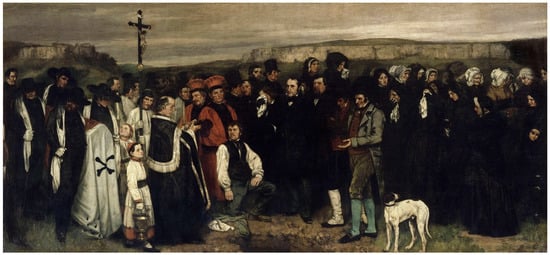
Figure 3.
Gustave Courbet, A Burial at Ornans. 1849–1850. Oil on canvas. 124 in × 260 in (315 cm × 660 cm). Musée d’Orsay, Paris.
Over the decades, achieving the “shock of the new” demanded increasingly extreme ploys. Challenging viewers veered into disturbing, disgusting, and horrifying them, including through the artists’ resort to self-harm as an artistic performance, such as Chris Burden’s Shoot (1971), which involved a friend shooting him in the arm with a 0.22 caliber gun. The urge to shock perhaps had its crescendo in the Sensation exhibition that debuted at London’s Royal Academy in 1997. It featured the work of Young British Artists from the collection of Charles Saatchi, including Marcus Harvey’s portrait of the serial killer Myra Hindley, her image shaped by children’s fingerprints, recalling the young age of her victims. This was the most controversial work at the exhibition’s London showing. In Brooklyn, it was Chris Ofili’s sexually charged painting of The Holy Virgin Mary (Figure 4). Her bare breast is formed from dried elephant dung, while dancing across the golden background are what appear from a distance to be butterflies, but on closer inspection are images of women’s buttocks cut from pornographic magazines. The Holy Virgin Mary is a long way from Giotto’s representations of Mary’s maternal tenderness that Clive Bell rejected for the human sympathy they elicited.
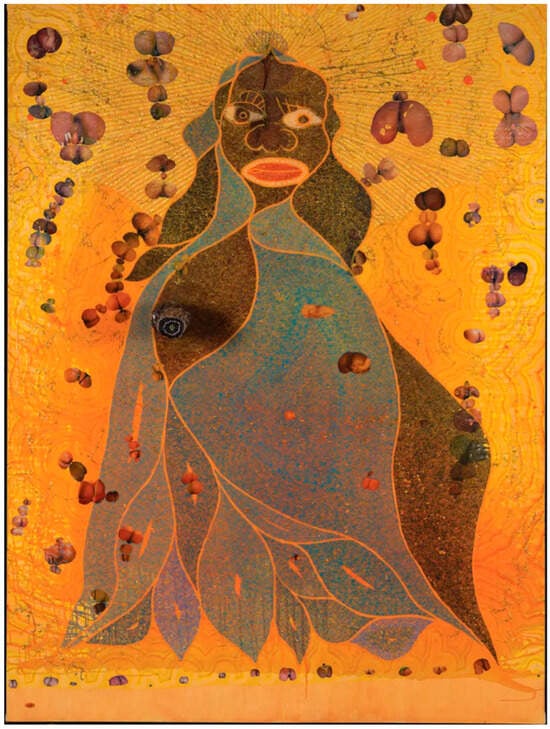
Figure 4.
Chris Ofili, The Holy Virgin Mary. 1996. Acrylic, oil, polyester resin, paper collage, glitter, map pins, and elephant dung on canvas. 96 in × 72 in (243.8 cm × 182.8 cm). Museum of Modern Art, New York. Gift of Steven and Alexandra Cohen. 211.2018.a–c https://www.moma.org/collection/works/283373, accessed on 1 December 2023.
With one taboo after another smashed, by the opening years of the twenty-first century, one of the last remaining was the sincere address of the tender and connective emotions. This is not to say that such emotions had disappeared from the art of the preceding 150 years. They could always be found in popular art, in films, on TV—that is, in the intellectually despised realm of mass culture. However, even within the work of the avant-garde, they are there. Such emotions are too vital a part of our human identity and experience to ever be completely extinguished. Search hard enough in the oeuvre of any artist, and you are likely to find at least traces of them.7
3. The Twenty-First Century
Into the twenty-first century, many artists have remained chary of embracing the softer emotions. Kiki Smith, discussing her installation Kitchen (2005), spoke of her desire to “play in a space that’s not very popular. To make things that border slightly on the saccharine, and on love, in a kind of old-fashioned way”. Yet, that desire was accompanied by an “uneasiness” about working in that “maligned territory” (Birks 2006). As recently as 2015, Sally Mann too expressed her wariness of “the deadly minefields of sentiment, that most disputed artistic territory” (Mann 2015, p. 83).
Yet, proscriptions against the expression of connective emotions and the solicitation of empathy have been dissolving.8 That dissolution accelerated during the pandemic, as the value of human connectedness to our individual well-being and to social justice movements, such as Black Lives Matter, was seared into our consciousnesses. Today, artists across the globe are re-embracing themes of love, care, empathy, and concern and, in many cases, harnessing them to advance social, political, and environmental justice. The expression of these emotions ranges from the boldly declarative to the quietly devastating. By way of conclusion, I will present two examples: Hank Willis Thomas’s The Embrace and Emily Hass’s Exiles series.
4. Hank Willis Thomas
The largest, most audacious expression of the value and importance of love created in recent years is Boston’s new memorial to Coretta Scott King and Martin Luther King, Jr., The Embrace (Figure 5).9 Unveiled in January 2023, it is a collaboration between Hank Willis Thomas, who designed the monumental bronze sculpture representing the intertwined arms of the Kings, and the MASS Design Group, who designed the 1965 Freedom Plaza on which it sits. The memorial is situated on the Boston Common, a short walk from one of the city’s busiest subway stops and just steps from the Parkman Bandstand from which, on 23 April 1965, Martin Luther King, Jr. addressed the 22,000 participants in the first civil rights rally that he had led outside of the South. However, this is not a memorial to Dr. King alone. It commemorates the shared achievements of the couple, who met and fell in love in Boston. Together, they confronted racism and social injustice; together, they sought to foster, in Dr. King’s famous words, a “beloved community”.
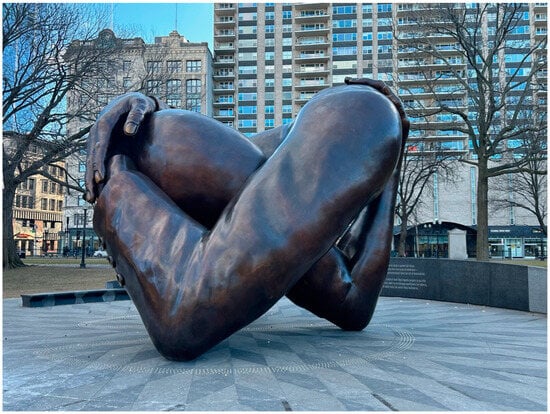
Figure 5.
Hank Willis Thomas in collaboration with the MASS Design Group, The Embrace. 2023. Bronze. 20 feet tall, 32 feet in diameter. Boston. Photo by author.
Thomas drew the image of the Kings’ embrace from a 1964 photograph taken at a news conference held soon after Dr. King was informed that he had been awarded the Nobel Peace Prize (Figure 6). He wraps his arms around his wife, resting his weight on her shoulders. The pose resonated with Thomas, who said that it spoke to him of “his partnership with his wife … Because it wasn’t ever just about him. It was about him and his family, but also about the community he was uplifted by”.10 The memorial, Thomas continued, is a “reminder that we all have the potential to embrace another that could have a transformative, productive impact for society”.11

Figure 6.
Unidentified photographer, Martin Luther King, Jr. and Coretta Scott King Embracing. 1964. BETTMANN ARCHIVE. https://hankwillisthomas.com/public-art/the-embrace, accessed on 15 December 2023.
The sculpture is enormous, twenty feet tall and thirty-two feet in diameter. Despite its size, it invites intimacy and engagement. On the summer afternoon of my visit, multiple children were racing around the sculpture, doing impromptu dances in and around it, and running their hands over its forms, making it the stage and central character of their play.
The best place to appreciate the sculpture is from within, standing at its center. There you are within the compass of the Kings’ huge and powerful arms, feeling the security, support, and empowerment of their embrace. The bronze, a rich chestnut brown, shimmers in the sunlight. Its smooth, sun-warmed surfaces entreat your touch and are meant to be touched. Above your head, the Kings’ arms frame an expanse of open sky (Figure 7). To Thomas, that circle of light evokes “the heavens”, and to a young member of the King family “a portal”.12 It opens to a luminous space of hope.
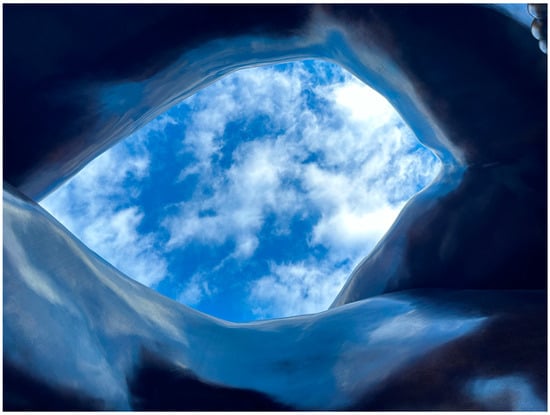
Figure 7.
Hank Willis Thomas, The Embrace, detail. View upward from the center of the sculpture. Photo by author.
Beneath the sculpture, the hard surface of the plaza stretches outward. It is composed of lozenges of granite, some light and some dark, arranged in a quilting pattern known as a starburst. The pattern summons associations with African-American quilting traditions, with communal work, and with warmth and comfort. The burst radiates centrifugally from the center to the outer edges of the plaza. Sixty-nine of the lozenges are edged with narrow bronze bars bearing the names of civil rights and social justice leaders who were active in the Boston area from the 1950s into the 1970s (Figure 8). These figures symbolically join the Kings in the community of which the viewer is made a part. The low stone wall encircling the plaza (which also serves as a bench) furthers the theme of embrace. Carved into one of its granite panels are the words of Coretta Scott King:
Love is such a powerful force.It’s there for everyone to embrace—that kind of unconditional love for all of humankind.That is the kind of love that impels people to go intothe community and try to change conditions for others,to take risks for what they believe in.

Figure 8.
MASS Design Group, 1965 Freedom Plaza, detail of pavement. Photo by author.
Her words and the memorial as a whole speak to the unifying and transformative power of love and to its vital role in the pursuit of social justice.
5. Emily Hass
Emily Hass’s Exiles series, including Hass family/Altonaer Straße, 2, Plan 10; Fleischmann family (Annelise/Anni Albers)/Meineskesstraße, 7, Plan 1; and Jacobson family/Wilhelmsaue, 3, Stairs 2 (Figure 9, Figure 10 and Figure 11), departs significantly in material and formal terms from The Embrace, yet it engages with equally powerful emotions centered on home and its loss.13 These small works on paper have their origin in Hass’s own family history. Her father was born into a Jewish family in Berlin. In 1938, when he was four years old, they fled the Nazi regime for London. They left behind their home on Altonaer Straße, a building that they would never see again.
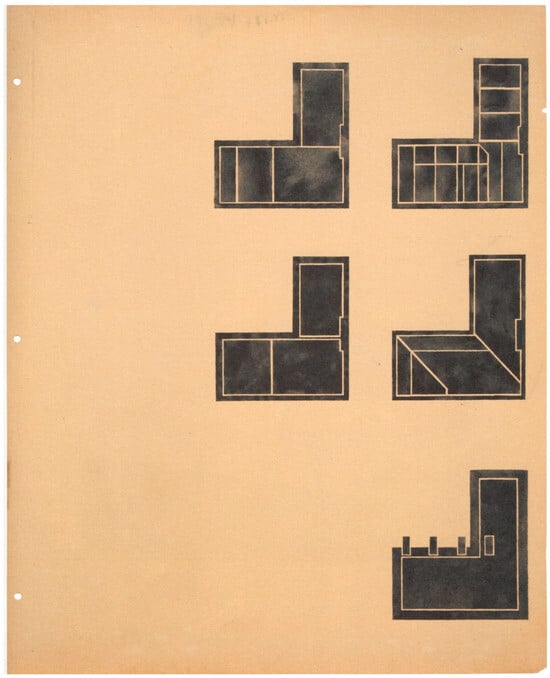
Figure 9.
Emily Hass, Hass family/Altonaer Straße, 2, Plan 10. 2011. Gouache on vintage paper. 19 × 23 inches. https://www.emilyhass.com/berlin/exiles/view/1115468/1/1115661, accessed on 1 December 2023.
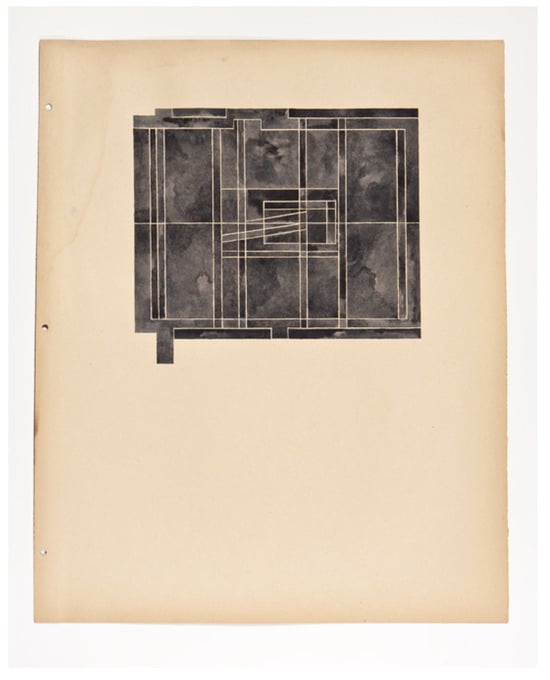
Figure 10.
Emily Hass, Fleischmann family (Annelise/Anni Albers)/Meineskesstraße, 7, Plan 1. 2009. Gouache on vintage paper. 19 × 23 inches. https://www.emilyhass.com/berlin/exiles/view/1115468/1/1115741, accessed on 1 December 2023.
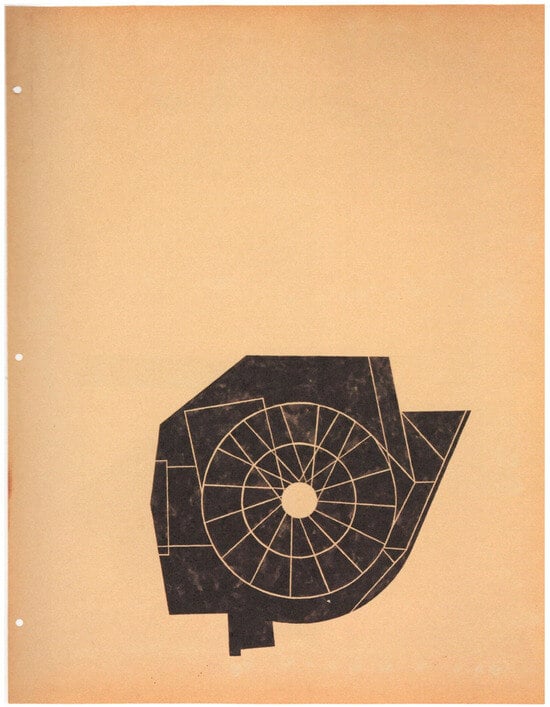
Figure 11.
Emily Hass, Jacobson family/Wilhelmsaue, 3, Stairs 2. 2011. Gouache on vintage paper. 19 × 23 inches. https://www.emilyhass.com/berlin/exiles/view/1115468/1/1115541, accessed on 1 December 2023.
In 2006 and again in 2008 (accompanied by her father), Hass traveled from her home in New York City to Berlin to seek traces of her family’s history. Altonaer Straße, 2 had been destroyed by Allied bombing, but in Berlin’s Landesarchiv, she found the original plans and sections for the house. This was as close as she could come to her father’s childhood home, and from this encounter came the first works that would evolve into the Exiles series. For ten years, Hass returned at least once a year to the Berlin architectural archives, extending her research from her family’s lost home to those of other Jews and persecuted artists and intellectuals who also had been driven from the city by the Third Reich in the 1930s. These include Josef and Anni Albers, Walter Gropius, Kurt Weil, Walter Benjamin, Lyonel Feininger, and Peter Gay. The works that grew from this research document not only devastating personal losses but also the city’s loss of a once vibrant culture.
“Home places”, writes the geographer Edward Relph, “are profound centres of human existence. A home is not just a house but an irreplaceable centre of meaning and the foundation of our identity as individuals and members of a community. It is a particular setting to which we are attached, and a point of departure from which we orient ourselves and grasp the larger world” (Relph 2018). So essential is home to our sense of self and to our feelings of belonging that its involuntary loss inflicts grievous wounds on the human psyche. Exiles, without a home that stabilized their identities, feel vulnerable, exposed, disoriented, and unmoored. So deep is the impact of exile that, as Hass knows, its effects may reverberate through multiple generations.
Hass composed the Exiles series with gouache on vintage paper, 19 x 23 inches. The works are strictly monochromatic, black gouache on aged paper. No other colors appear anywhere in the series. The imagery is drawn directly from the architectural drawings in the huge dusty volumes of the Berlin archives. With her deep respect for the traumatic stories bound to the plans, Hass does not permit herself to add anything to the imagery that she found in them. However, she does allow herself to subtract. Those informative details that render plans legible and usable—scale, compass direction, symbol keys, and room usage indications, such as plumbing fixtures—are all removed. The elimination of these markers of legibility resonates with the dislocating and disorienting impact of exile.
In Hass’s presentations, the plan-derived forms are abstracted and simplified. Their spare, minimalist, hard-edged geometries belong to the language of High Modernism, summoning thoughts of the efflorescence of that style in Germany before the Nazi purges. While the shapes remain true to those in the plans, Hass has reversed the coloration. Instead of black lines bounding white spaces, the spaces are filled with black gouache and the lines are created through reserving the bare paper. It is as though we are looking at the ghostly afterimage of the plans. The impression of spectral presence is reinforced by the application of the gouache in soft washes. They float as dark, wafting mists through the empty chambers.
Each form in the Exiles series belongs to a narrative, a story of forced displacement and devastating loss. Fittingly, Hass represented these forms on paper that also has a history. In a flea market on Cape Cod, she found an old scrapbook, its pages browned and spotted. Pale squares and flecks of tape marked places where photographs had been removed. Three-hole punch marks on the left side of each page indicate that the now single sheets once belonged to a group—to a longer sequence and a larger story. The pages are resonant with memories once preserved and now lost. They also echo the aged paper of the archival volumes in which Hass did her research and from which she drew the architectural forms.
Every aspect of the series—the materials, the application, and the imagery—bears connections to narratives of persecution and profound loss, drawing our empathetic compassion for those whose lives they reference. Yet, Hass handles the subject with such subtlety and sensitivity—in a formal language of hard-edged geometries that seems to hold emotions at bay—that without the aid of titles and labels, a viewer might well perceive the drawings as pure abstractions. Hass accepts this. She regards the shapes as containers. They hold the absences of those driven from their homes, but still, she wants the forms to be open to other meanings. “I want each person”, she says, “to be able to project whatever they want” into them. This is a generosity to her viewers, but it is knowing the origins of the shapes that unseals their haunted histories, unleashes their emotional power, and allows them to serve in memoriam for lives shattered and a culture lost.
Emily Hass and Hank Willis Thomas draw on their deep wells of empathy to express and elicit respect and compassion for their subjects. Their art reaches outward to touch and move the viewer. It connects them to issues of vital importance in the world today: racial justice, refugee crises, and our overwhelming human need for home, family, community, and love. Hass and Thomas are but two of a host of artists around the globe who are making a place for emotions in their work, who feel no embarrassment in touching hearts, and who recognize, as the writer Jimmy Wu proclaimed in the words taken as the title of the recent Ford Foundation Gallery exhibition, “There is no justice without love”.14
Funding
This research received no external funding.
Data Availability Statement
No new data were created or analyzed in this study. Data sharing is not applicable to this article.
Conflicts of Interest
The author declares no conflict of interest.
Notes
| 1 | Leys (2017). The literature on affect is extensive. A place to begin is (Gregg and Seigworth 2010); the editors define affect as “force or forces of encounter” (2). |
| 2 | Reddy (2001). Reddy expands on his concept of “emotional regimes” in (Plamper 2010). |
| 3 | Diderot (1795), quoted in (Fried 1980, pp. 79–80). Fried offers the original French and his own translation; my translation relies substantially on his. The original French reads, “Touche-moi, étonne-moi, déchire-moi, fais-moi tressaillir, pleurer, frémir, m’indigner d’abord; tu récréeras mes yeux après, si tu peux”. |
| 4 | Ruskin (1856, p. 14) [“Of the Turnerian Picturesque” sections 12 & 16]. https://art-bin.com/art/oruskin1.html, accessed 15 November 2023. |
| 5 | On the history of sentimental art, see (Bedell 2018; Barker 2005). |
| 6 | Schjeldahl (2020). Schjeldahl quotes Judd on pursuing an aesthetic that would be “non-naturalistic, non-imagistic, non-expressionist”. |
| 7 | A number of scholars have written about the emotions that surface in different ways in Minimalist art. See (Best 2011; Currie 2014). |
| 8 | I am uncertain when—or even if it is possible to pinpoint when—the tide began to turn in favor of the artistic embrace of the softer, connective emotions. Possibly in the 1990s. Possibly earlier, possibly later. The AIDS epidemic may have played a part as artists gave expression not only to anger and outrage but also to grief, care, and concern. Among critics, Eve Kosofsky Sedgwick’s writings from the later 1990s onward, such as (Sedgwick 2003), have provided a model of generous, empathetic, emotionally engaged criticism that pays explicit attention to the affective dimensions of the texts it addresses. |
| 9 | On The Embrace, see “About The Embrace”, Embrace Boston website, https://stories.embraceboston.org/about/about-the-embrace, accessed on 30 November 2023; “Unveiling The Embrace Boston Designed by Hank Willis Thomas”, published 13 January 2023, Pace Gallery website, https://www.pacegallery.com/journal/unveiling-hank-willis-thomas-embrace-memorial-in-boston/, accessed on 1 December 2023; ART21, “Hank Willis Thomas in ‘Bodies of Knowledge”, https://art21.org/watch/art-in-the-twenty-first-century/s11/hank-willis-thomas-in-bodies-of-knowledge/, accessed on 1 December 2023. |
| 10 | Hank Willis Thomas, quoted in (Ross 2023). |
| 11 | Same to Note 10. |
| 12 | Hank Willis Thomas recalling the words of Yolanda King in (Ross 2023). |
| 13 | Unless otherwise noted, information about the Exiles series is drawn from my interview with Emily Hass on 6 October 2023, her monograph Exiles (2021), and her personal website: https://www.emilyhass.com/, accessed on 18 February 2024. |
| 14 | Ford Foundation Gallery website: https://www.fordfoundation.org/about/the-ford-foundation-center-for-social-justice/ford-foundation-gallery/exhibitions/no-justice-without-love/, accessed on 18 February 2024. |
References
- Barash, Moshe. 1990. Modern Theories of Art I: From Winckelmann to Baudelaire. New York: New York University Press. [Google Scholar]
- Barker, Emma. 2005. Greuze and the Painting of Sentiment. Cambridge: Cambridge University Press. [Google Scholar]
- Barnett, Michael N. 2011. Empire of Humanity. Ithaca: Cornell University Press. [Google Scholar]
- Baudelaire, Charles. 1965. On M. Ary Scheffer and the Apes of Sentiment. In Art in Paris, 1845–1862. Edited and Translated by Jonathan Mayne. London: Phaidon. [Google Scholar]
- Bedell, Rebecca. 2018. Moved to Tears: Rethinking the Art of the Sentimental in the United States. Princeton: Princeton University Press. [Google Scholar]
- Bell, Adrienne Baxter, ed. 2006. George Inness: Writings and Reflections on Art and Philosophy. New York: George Braziller. [Google Scholar]
- Bell, Clive. 1914. Art. New York: Frederick A. Stokes Co. [Google Scholar]
- Best, Susan. 2011. Visualizing Feeling: Affect and the Feminine Avant-Garde. London: I.B. Taurus. [Google Scholar]
- Birks, Kim. 2006. “Recent Acquisition: Kiki Smith, Kitchen, 2005”, Walker Art Center Website, Posted April 1. Available online: https://walkerart.org/magazine/recent-acquisition-kiki-smith-kitchen-2005 (accessed on 15 December 2023).
- Currie, Nick. 2014. Minimalism as Pathos. Mousse Magazine, November 12. Available online: https://www.moussemagazine.it/magazine/minimalism-as-a-pathos-nick-currie-2014/ (accessed on 16 December 2023).
- Diderot, Denis. 1795. Essais sur la Peinture. Paris: Buisson. [Google Scholar]
- Fried, Michael. 1980. Absorption and Theatricality: Painting and Beholder in the Age of Diderot. Berkeley: University of California Press. [Google Scholar]
- Gregg, Melissa, and Gregory J. Seigworth, eds. 2010. The Affect Theory Reader. Durham: Duke University Press. [Google Scholar]
- Hunter, Sam. 1956–1957. Jackson Pollock. The Bulletin of the Museum of Modern Art 24: 3–16. [Google Scholar] [CrossRef]
- Inness, George. 1878. A Painter on Painting. Harper’s New Monthly Magazine 56: 458–46. [Google Scholar]
- Inness, George. 1879. Mr. Inness on Art-Matters. Art Journal 5: 374–377. [Google Scholar]
- LeWitt, Sol. 1967. Paragraphs on Conceptual Art. Artforum 5: 79–84. [Google Scholar]
- Leys, Ruth. 2017. The Ascent of Affect: Genealogy and Critique. Chicago: University of Chicago Press. [Google Scholar]
- Mann, Sally. 2015. Hold Still. New York: Little Brown. [Google Scholar]
- Plamper, Jan. 2010. The History of Emotions: An Interview with William Reddy, Barbara Rosenwein, and Peter Stearns. History and Theory 49: 237–65. [Google Scholar] [CrossRef]
- Reddy, William M. 2001. The Navigation of Feeling: A Framework for the History of Emotions. New York: Cambridge University Press. [Google Scholar]
- Relph, Edward. 2018. Place and Placelessness Summarized. Posted by the Author to Academic.edu. Available online: https://www.academia.edu/36528536/A_Summary_Version_of_Place_and_Placelessness (accessed on 15 December 2023).
- Rodman, Selden. 1961. Conversations with Artists. New York: Capricorn Books. [Google Scholar]
- Ross, Janell. 2023. The Artist Behind the New MLK Jr. Sculpture Has a Message for Its Critics. Time, January 22. Available online: https://time.com/6249068/martin-luther-king-sculpture-hank-willis-thomas-interview/ (accessed on 1 December 2023).
- Roth, Moira. 1977. The Aesthetic of Indifference. Artforum 16: 46–53. [Google Scholar]
- Ruskin, John. 1856. Modern Painters. London: Smith, Elder, vol. 4. [Google Scholar]
- Schjeldahl, Peter. 2020. The Cold Imperious Beauty of Donald Judd. The New Yorker, March 9. [Google Scholar]
- Sedgwick, Eve Kosofsky. 2003. Touching Feeling: Affect, Pedagogy, Performativity. Durham: Duke University Press. [Google Scholar]
- Shaviro, Steve. 2004. The Life, After Death, of Postmodern Emotions. Criticism 46: 125. [Google Scholar] [CrossRef]
- Warhol, Andy. 1975. The Philosophy of Andy Warhol. New York: Harcourt. [Google Scholar]
- Whistler, James Abbott McNeil. 1892. The Red Rag. In The Gentle Art of Making Enemies. London: William Heinemann. [Google Scholar]
Disclaimer/Publisher’s Note: The statements, opinions and data contained in all publications are solely those of the individual author(s) and contributor(s) and not of MDPI and/or the editor(s). MDPI and/or the editor(s) disclaim responsibility for any injury to people or property resulting from any ideas, methods, instructions or products referred to in the content. |
© 2024 by the author. Licensee MDPI, Basel, Switzerland. This article is an open access article distributed under the terms and conditions of the Creative Commons Attribution (CC BY) license (https://creativecommons.org/licenses/by/4.0/).